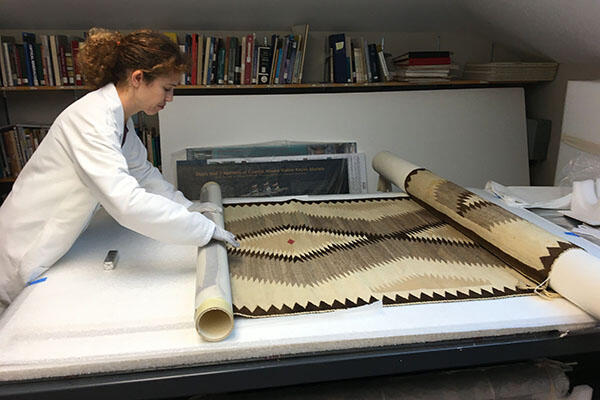What is rehousing?
Rehousing is the term we use to describe the construction of a new storage container for an object, using inert and archival materials. This includes custom-made archival board enclosures, creation of supports for the delicate objects in open trays/shelving, or even mounts to stabilize objects for storage and freezing, if necessary.
How do we rehouse cultural heritage objects?
Designing these enclosures or supports can be challenging and require careful research and measuring prior to starting. First, the object is thoroughly examined to decide how it should best be supported in its housing. Areas of structural instability or particularly delicate areas are prioritized. In the case of rehousing, the shape of the object, the measurements for its enclosure, and the ideal materials to be used are carefully thought out. Objects should be safely and securely situated within their housing, with vulnerable areas stabilized by supports during movement. Additionally, we aim to create containers that are close to the footprint of the object to save room within storage areas.
Most importantly, we pay close attention to care and handling instructions kindly provided to us by source communities, such as creating breathable enclosures for certain objects needing it.
What materials do we use and why?
To create these enclosures, supports, and mounts, we make sure to use materials that are safe for the storage of cultural heritage objects, also known as archival materials. Items such as acid-free tissue paper, Tyvek® wrap, archival-grade blue board, and various inert foams like Ethafoam® and Volara are just some of the more common materials used. These materials have been researched and are determined to be safe for cultural heritage materials.
An example: the Textiles Rehousing Project

Fig. 1. Conservator Ayelet Grinstein rolls a Navajo textile onto an acid-free tube.
- What is the Textiles Rehousing Project?
This project was started during the examination, assessment, and cleaning of textiles following the webbing clothes moth incident that occurred in 2016. The textiles were not previously stored ideally, and so efforts were made to include that in the Moth Mitigation Project activities.
- What are the steps for rehousing a textile?
Rehousing a textile can be difficult and often requires more than one person. After it has been cleaned, an archival-grade, acid-free blue board tube is cut to the size of the textile. Acid-free tissue paper is placed on the outside and inside of the textile and all rolled carefully together so that there is interleaving tissue paper between the layers of textile. The entire rolled textile is placed into a polyethylene tube and tied off at both ends to protect against pests in storage.